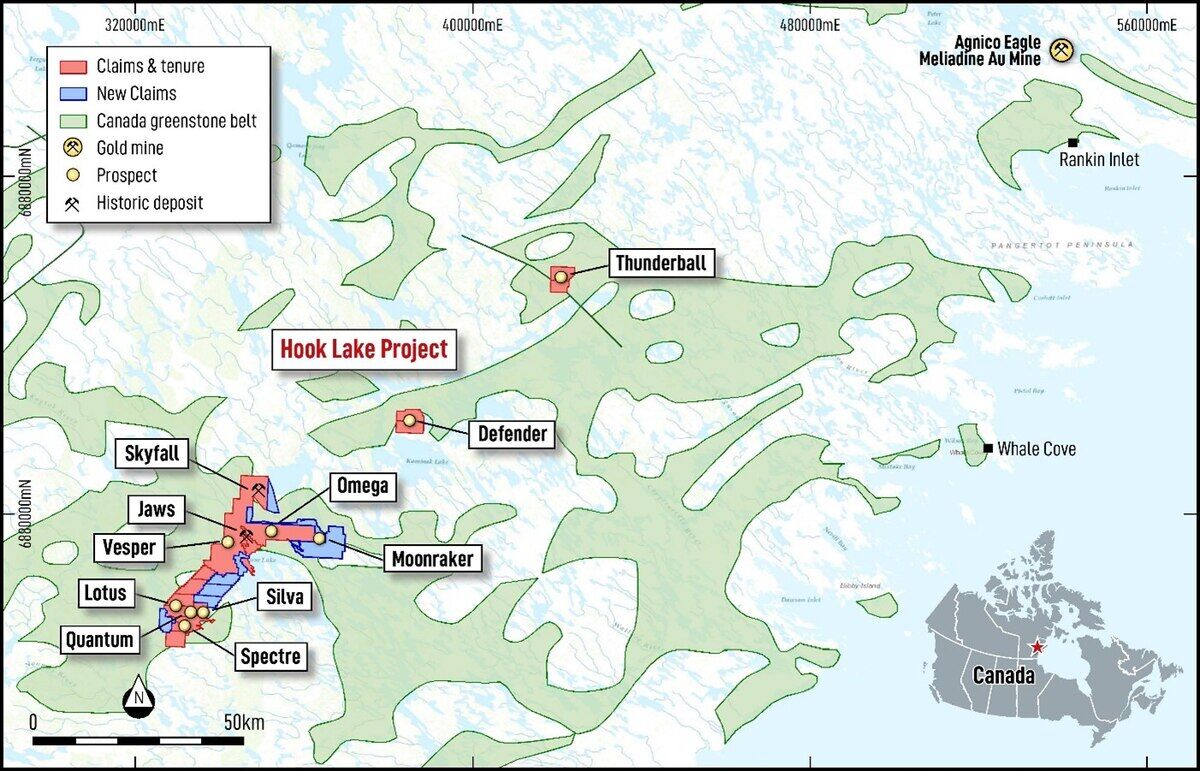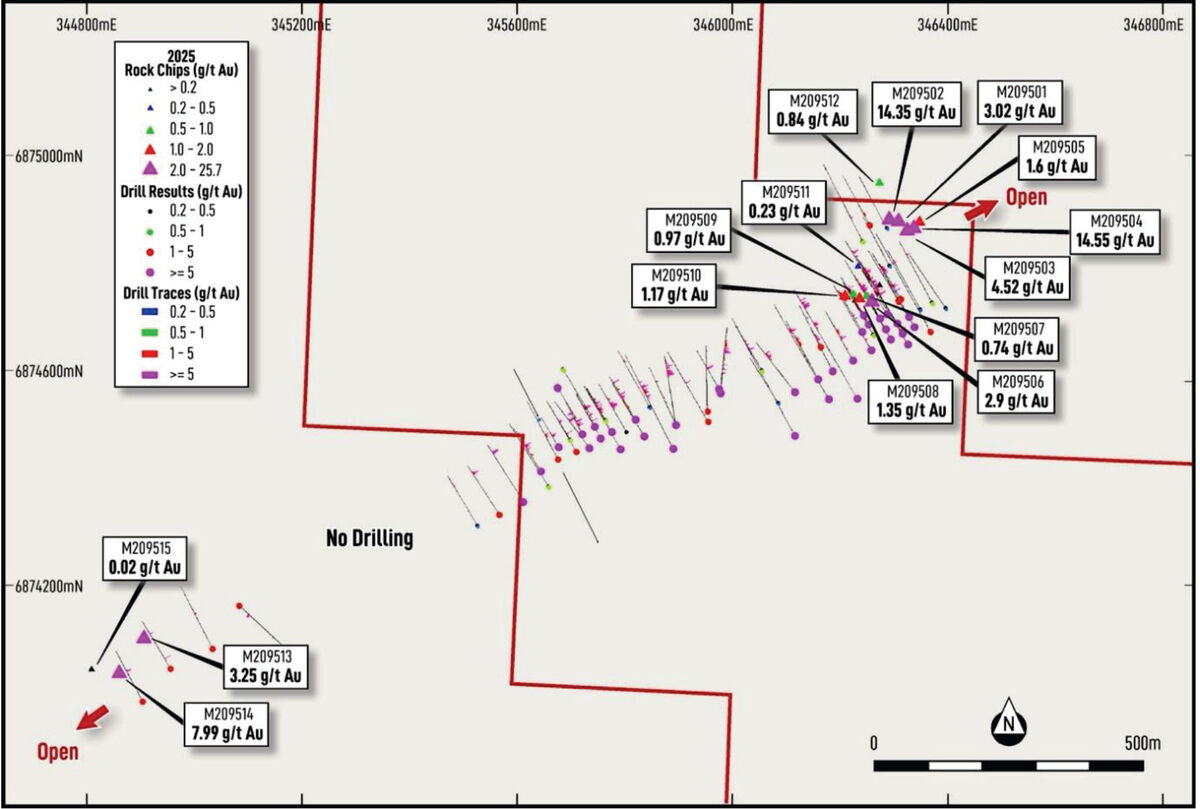Manhattan Corporation Ltd. Oct. 23 announced that its inaugural field program at Hook Lake has confirmed and expanded upon a high-grade gold system at the Jaws target on this district-scale project in Nunavut.
“The maiden field results from Hook Lake exceeded the company’s expectations, confirming the presence of a large and highly prospective gold system,” said Manhattan Corporation Technical Manager Eric Sondergaard.
Manhattan Corporation Ltd.
Lying about 225 kilometers (140 miles) southwest of Agnico Eagle Mines Ltd.’s 6.7-million-ounce Meliadine gold mine, Hook Lake covers 423 square kilometers (163 square miles) of the Rankin-Ennadai greenstone belt in southeastern Nunavut.
Australia-based Manhattan Corporation’s 2025 field program focused on Jaws (formerly Turquetil Lake), the most advanced of 11 historical deposits and prospects at Hook Lake. Based on exploration carried out in the 1970s and 80s, Jaws hosts an estimated 3.4 million metric tons of historical resource averaging 2.38 grams per metric ton (285,000 ounces) gold.
The company reports that 20 rock chip samples collected from the Jaws and nearby Vesper targets this year have confirmed that gold mineralization in the Jaws area of Hook Lake extends for at least 4.7 kilometers (2.9 miles) and that some of the highest-grade samples collected are in areas not tested by historical drilling.
Highlights from 15 rock chip samples include:
Manhattan Corporation Ltd.
• 14.35 g/t gold (M209502).
• 4.52 g/t gold (M209503).
• 14.55 g/t gold (M209504).
• 2.9 g/t gold (M209506).
• 3.25 g/t gold (M209513).
• 7.99 g/t gold (M209514).
The two highest-grade samples – M209502 and M209504 – were collected to the northeast of drilling at Jaws.
“The discovery of compelling gold grades at the north-eastern margin of the Jaws deposit highlights significant potential to extend mineralisation into completely untested ground and expand the overall footprint of the system,” said Sondergaard.
The 2025 sampling also indicates the potential to expand the historical Jaws deposit to the southwest.
Collected in an extension area about 500 meters southwest of the historical Jaws deposit, samples M209513 and M209514 confirm the expansion potential in this direction. M209513, which also returned 15.3 g/t silver, 1.19% copper, and 0.89% antimony, also indicates the polymetallic potential at Jaws.
Sampling of the Vesper target, located within the same shear zone as Jaws, about three kilometers (1.9 miles) southwest of the furthest out drill hole, encountered strong gold mineralization in similar veins and alteration styles. Samples collected from Vesper returned 1.61 g/t and 1.15 g/t gold.
“These results reinforce the scale and continuity of gold mineralization along the Hook Lake corridor, supported by robust alteration and encouraging copper, silver, and antimony values. The system displays the characteristics of a major gold district,” Sondergaard added.
Manhattan Corporation Ltd.
High-grade copper samples collected from an outcrop at the Skyfall target.
In addition to Jaws-Vesper, Manhattan Corporation collected 17 samples from the Quantum and Lotus prospects toward the southwest end of the Hook Lake property; 16 samples from Skyfall, an underexplored volcanogenic massive sulfide (VMS) copper-zinc target about 10 kilometers (six miles) north of Jaws; and seven samples from the Spectre and Silver VMS showings to the southeast of Quantum and Lotus. Assays are pending for the samples collected from these targets.
In addition to sampling, the company is having a high-resolution magnetic survey flown over the Hook Lake project. The survey will provide insights into the structural setting of mineralisation at the Jaws deposit and help tie together the locations sampled toward Vesper to the southwest. It will also help reveal the potential continuity at Lotus and Vesper, where mineralized quartz veins extend under glacial sediments.
“These activities lay the foundation and focus for inaugural drilling in early 2026,” said Manhattan Corporation CEO Kell Nielsen. “Discussions with contractors, First Nations, and permitting authorities are well underway to ensure we are well positioned to move rapidly into the next phase of exploration.”
Author Bio
Shane Lasley, Publisher
Over his more than 18 years of covering mining and mineral exploration, Shane has become renowned for his ability to report on the sector in a way that is technically sound enough to inform industry insiders while being easy to understand by a wider audience.




